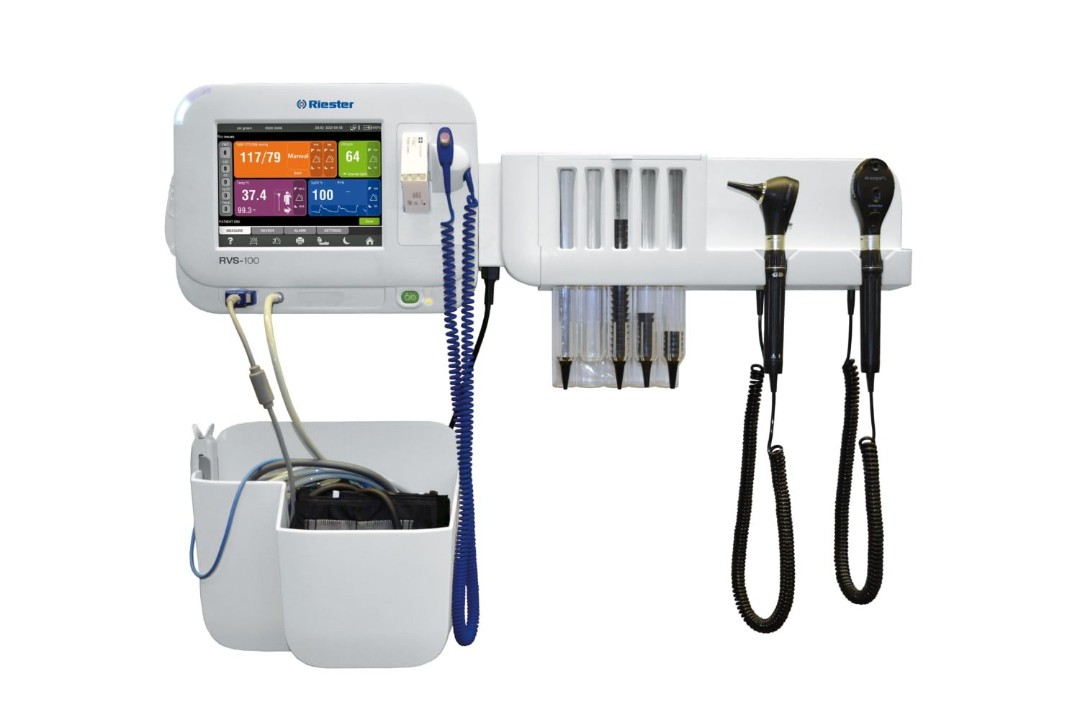RVS-200 is a versatile, integrated modular wall diagnostic station which like the RVS-100 measures pulse rate (PR), oxygen saturation (SpO2), non-invasive blood pressure (NIBP) and temperature (oral/axillary probe) with the additional option to add ophthalmoscopes, otoscopes and dermatoscopes. The flexible, modular design offers many configurations and settings to suit the needs of hospitals and clinics as well as office based and long-term care settings.

can be programmed with NEWS (National Early Warning Signs, 1997), MEWS (Modified Early Warning Signs, 2001) and also has 5 customisable profiles which can be set by the end-user if they have different parameter values. RVS-200 provides the additional benefit to for the healthcare professional (HCP) to be able to assess their patient’s eyes, ears and skin making it suitable to diagnoses a wide range of conditions across ENT and Dermatology.
The device has ‘Monitor‘, ‘Spot Check‘ and ‘Triage‘ profile options, as well as a ‘Demo’ mode.
Continuous Monitoring is designed for monitoring patients over time and includes physiological and technical alarms. Spot Check is designed for taking a single set of vital signs measurements on a patient. Patient information can be entered and managed, and while technical alarms are still available, physiological alarms are disabled. Triage is designed for rapidly taking vital signs measurements on many patients. Patient information is disabled, in addition to physiological alarms. Demo mode demonstrates how each measurement mode works.
Large 8“ full HD colour TFT-LCD screen displays large numbers and bright colour-coded parameters so that vital signs can be seen clearly and interpreted easily.
Screen is visible in both dark and lit rooms.
The touch screen and intuitive user interface makes it quick and easy for patient information to be entered and settings amended as required.
The modular design is chosen by the customer around their needs, starting with the choice between a table/mobile stand or wall mounted, through to the optional accessories like a printer.
Can be plugged into the mains or powered off the battery for 17 hours.2
Riester is committed to providing reliable clinical measurements, including the choice of SpO2:
Centralised power supply supports up to 3 diagnostic handles, from a choice of Riester ri-scope® L and EliteVue instrument heads:
Integrated specula dispenser for the otoscope and nasal specula with 5 tubes for 5 different sizes of specula, dispenses a new specula for each examination and is easy to re-fill and disinfect.
| Power supply | 100 – 240 V AC, 50/60 Hz |
| Battery | Lithium-Ion battery, rechargeable, 10.8 V DC, 6,600 mAh. Charging time to a 100%: 6 hours, Operating time approx. 11 hours (new and fully charged battery at 25°C ambient temperature with connected SpO2, Temp, and NIBP on AUTO mode (15 minutes interval), Low battery indicator, Charging battery indicator |
| Monitor dimensions | 303 x 230 x 110 mm (11.93 x 9.05 x 4.33 in) |
| Monitor weight | 3600 g (7.94 lb) inc. temperature module, printer |
| Basket dimensions | 270 x 225 x 200mm (10.63 x 8.86 x 7.87 in) |
| Alarm | Visible LEDs (Yellow, Red, Blue, Green, Orange) Audible Speaker, Gives audible alarm, QRS tone. Supports Pitch Tone and multi-level volume. Alarm tones meet the requirement of IEC 60601-1-8. Alarm Pressure: 45 dB to 85 dB test distance is 1 meter from the tone |
| Ports | 1 x AC power inlet 1 x standard RJ45 interfaces.100 BASE-TX, IEEE 802.3 4 x USB ports 1 x Equipotential grounding point 1 x RJ11 connector for nurse call DC out port 15V/1.2 A |
| Measuring method | Automatic oscillometric |
| Measurement range | Adult SYS 30 – 270 mmHg, DIA 10 – 220 mmHg, MAP 20 – 235 mmHg Paediatric SYS 30 – 235 mmHg, DIA 10 – 220 mmHg, MAP 20 – 225 mmHg Neonate SYS 30 – 135 mmHg, DIA 10 – 110 mmHg, MAP 20 – 125 mmHg |
| Cuff pressure range | 0 – 280 mmHg |
| Resolution | 1 mmHg |
| Pressure accuracy | Static ±3 mmHg Clinic ±5 mmHg, standard deviation ≤ 8 mmHg |
| Pulse rate range | 40 – 240 bpm |
| Pulse rate accuracy | 1 bpm |
| Initial inflation pressure | Adult 160 mmHg, Paediatric 130 mmHg, Neonate 75 mmHg Double overpressure protection (hardware and software). Adult 297 ± 3 mmHg, Paediatric 252 ± 3 mmHg, Neonate 147 ± 3 mmHg |
| Alarm range | SYS 0 – 300 mmHg DIA 0 – 300 mmHg MAP 0 – 300 mmHg |
| Measurement range | 0 – 100% |
| Resolution | 1% |
| Accuracy | ±2% (70 to 100%) ±3% (40% to 69%) Unspecified (0% to 39%) |
| Alarm range | 0 – 100% |
| Average time | 4 sec, 8 sec, 16 sec |
| Pulse rate Measurement range |
20 – 250 bpm |
| Pulse rate Resolution | 1 bpm |
| Pulse rate Accuracy | ±1% or ±1 bpm which ever is greater |
| Measurement range | 0 – 100% |
| Resolution | 1% |
| Accuracy | 70 – 100%: ±2% (adult, paediatric) 70 – 100%: ±3% (neonate) 0 – 69%: unspecified |
| Alarm range | 0 – 100% |
| Average time | 8 sec, 16 sec |
| Pulse rate Measurement range |
20 – 300 bpm |
| Pulse rate Resolution | 1 bpm |
| Pulse rate Accuracy | 20 – 250 bpm: ±3 bpm 251 – 300 bpm: unspecified |
| Measurement range | 0 – 100% |
| Resolution | 1% |
| Accuracy | 70 – 100%: ±2% (adult, paediatric, non-motion conditions) 70 – 100%: ±3% (neonate, non-motion conditions) 70 – 100%: ±3% (motion conditions) 0 – 69%: unspecified |
| Alarm range | 0 – 100% |
| Average time | 2 – 4 sec, 4 – 6 sec, 8 sec, 10 sec, 12 sec, 14 sec, 16 sec |
| Pulse rate Measurement range |
25 – 240 bpm |
| Pulse rate Resolution | 1 bpm |
| Pulse rate Accuracy | ±3 bpm (non-motion conditions) ±5 bpm (motion conditions) |
| Oral (Quick Mode) | non-fever temps: 3 - 5 seconds, fever temps: 8 - 10 seconds |
| Oral (Standard Mode) | 6 - 10 seconds |
| Axillary Mode | 8 – 12 seconds |
| Rectal Mode | 10 – 14 seconds |
| Direct Mode (all sites) | 60 – 120 seconds |
| Measurement accuracy | 35.5°C - 42°C Direct Mode (all sites): ±0.1°C (±0.2°F) Standard Mode (all sites): ±0.1°C (±0.2°F) Quick Mode (oral only): ± 0.3°C (±0.5°) |
